#and also bhai tika specifically being a celebration that is-
Explore tagged Tumblr posts
Text

my visionboard. btw.
#mainly because i assumed bellara was nepali for no good reason and found out she is modelled after her voice actor (south korean)#but it was too late and i'd decided things for myself#and partially because the hanbok and top from the daura-suruwal is so similarly cut#but its like its flipped.? visually that was just appealing for me to incorporate#and also bhai tika specifically being a celebration that is-#part of a week long festival and one day is to honor your brother. ohhh i just know the first bhai tika after cyrian apparently died#would have been so hard for her. and the whole thing about if there's a death in your family in nepali culture#there are no celebrations at all to mourn. yeah. im concocting something#bellara lutare#cyrian lutare#i also just. adore the idea of them during lunar new year. AARRUUGUGGHHHHH I LOVE YOU GUYS#AND ALSO. THE SCARF IS A DUPATTA
35 notes
·
View notes
Text
The Significance and Traditions of Bhai Dooj: Celebrating the Bond between Brothers and Sisters

Introduction: Bhai Dooj, also known as Bhai Tika or Bhai Phonta in different regions of India, is a joyous festival that celebrates the beautiful bond shared between brothers and sisters. This auspicious occasion falls on the second day after Diwali, when sisters pray for the well-being and prosperity of their brothers. In return, brothers vow to protect and support their sisters throughout their lives. Let's explore the significance and traditions of Bhai Dooj, and how it strengthens the sibling relationship.
Symbolism and Religious Beliefs: Bhai Dooj holds a special place in Hindu culture as it symbolizes the eternal bond between siblings. It is believed that on this day, Yamaraj (the God of Death) visited his sister Yami, who performed the traditional tilak ceremony and offered him sweets. Impressed by her love and affection, Yamaraj granted her immortality and promised to protect her. Hence, Bhai Dooj is observed as a day to pray for the long life and prosperity of brothers.
Traditions and Rituals: Bhai Dooj is marked by various customs and rituals that vary across regions. The celebration typically begins with sisters applying a tilak (vermillion mark) on the forehead of their brothers. This tilak is considered auspicious and is believed to protect brothers from evil forces. Sisters also perform aarti (ritual of waving lamps) for their brothers and offer them delicious sweets and gifts as a token of love.
One of the unique customs of Bhai Dooj is the exchange of heartfelt promises. Brothers pledge to protect and support their sisters, while sisters promise to pray for their brothers' well-being always. This exchange reinforces the bond between siblings and signifies their lifelong commitment to each other.
Diverse Perspectives: Bhai Dooj is not limited to the Hindu community alone; it is celebrated with equal enthusiasm by people of various religions and cultures. The festival transcends religious boundaries and serves as a reminder of the importance of familial relationships and sibling love. In fact, it is common to see people from diverse backgrounds participating in the festivities, highlighting the inclusiveness and universality of this festival.
Statistics and Cultural Impact: While specific statistics regarding Bhai Dooj celebrations may be limited, it is evident that this festival holds a significant place in Indian society. The exchange of gifts and sweets during Bhai Dooj contributes to the country's economic growth, with the market witnessing a surge in sales of traditional attire, sweets, and gifts during the festive season.
Moreover, Bhai Dooj fosters a sense of togetherness and strengthens familial bonds as families come together to celebrate this auspicious occasion. The festival promotes unity, love, and respect among family members, fostering a sense of belonging and emotional well-being.
Conclusion: Bhai Dooj presents an opportunity to celebrate the deep-rooted love and affection between brothers and sisters. It is a time to reflect upon the significance of this sacred bond that transcends all boundaries. This festival not only brings joy and merriment but also teaches us the value of nurturing and cherishing relationships throughout our lives.
As we celebrate Bhai Dooj, let us appreciate the incredible support, love, and guidance that our brothers and sisters provide, and cherish their companionship for years to come.
Sources:
"Bhai Dooj" - CulturalIndia.net: [https://www.culturalindia.net/festivals/bhaubeej.html]
"Bhai Dooj - The Festival of Brothers and Sisters" - IndiaParenting.com: [http://www.indiaparenting.com/festivals-and-celebrations/205_5737/bhaubeej-or-bhai-dooj.html]
"Celebrating Bhai Dooj: Significance and Rituals" - ModuleKart Blog: [https://modulekart.com/blog/celebrating-bhai-dooj-significance-and-rituals/]
"Bhai Dooj: Festive Sales to Take Retailers Out of Covid Shadow" - The Economic Times: [https://economictimes.indiatimes.com/industry/cons-products/fashion-/-cosmetics-/-jewellery/bhai-dooj-festive-sales-to-take-retailers-out-of-covid-shadow/articleshow/71605166.cms]
0 notes
Text
Festivals In Nepal You Must Experience
Nepal is one of the few diverse country with many differences in nature, culture, religion, lifestyle, etc. Every village in Nepal values its traditions in a unique way. Many of these traditions are centuries old and are done for specific purposes. Every country respects the culture of other countries. This is the main reason for the harmonious way of life in Nepal. Despite its small size, the Himalayan nation is home to many different cultures and tribes with different traditions and rituals. Because of their different ethnic groups, the Nepalese people have different beliefs and customs. Despite this, everyone is united for the celebration of the great festivals. Festivals like Dashain and Tihar are nationally important; like Indra Jatra or Rato Machchhendranath Jatra, which belongs to the ancient village culture of the valley, but others are only seen by one tribe. The cultural diversity of Nepal can be seen in the various festivals that are celebrated in the country. However, there are lots of festivals in Nepal, which are also popular with tourists from different parts of the world. To take a closer look at the diversity of Nepal, here is a list of festivals in Nepal.
Dashain
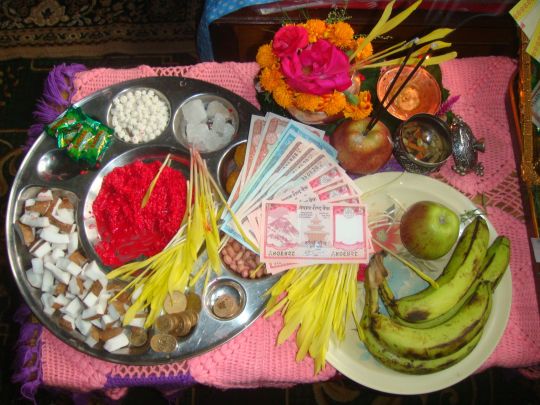
Dashain is one of the biggest and most popular festival of Hindu. Dashain is the festival of Goddess Durga's victory over the evil Mahishasura, according to Hindu mythology. Nepalese people celebrate Dashain for fifteen days by spending time with their family members eating delicious food and receiving tika and blessings from elders. It is one of the few festivals celebrated by many people of Nepal. The first day of Dashain is celebrated as Ghatasthapana, the beginning of the festival. People worship the eight tantric goddesses on the first day and the next nine days are dedicated to each form of Durga.
Tihar

After Dashain Tihar is another biggest festival of Hindu which is right after Dashain. Tihar is celebrated for five days. The first two days are celebrated with the worship of crows and dogs. On the third day, people sprinkle crackers and light small clay lamps in their homes. On the fourth day, cows are worshiped in the morning, and in the evening you can watch the special Govardhan Pooja. If you visit the Newar community, the fourth day is celebrated as Mha Puja, the New Year. The last day is Bhai Tika (Brothers' Day). This ceremony is done between the brothers and sisters of the family. Sisters pray for the welfare of their brothers and apply tika on their foreheads for long life. On the other hand, brothers give their sisters sweets and gifts. They follow special rituals during this festival.
Teej
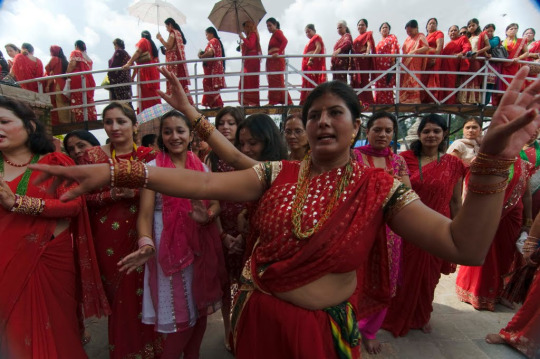
Teej is one of the biggest festivals in Nepal, celebrated by women. Traditionally, it is a great day for married women, who visit their mother's house and eat a traditional meal called Dar. After Dar, women fast for a whole day without eating or drinking while singing and dancing in groups. Many women go to Pashupatinath to pray. Teej is celebrated for three days. On the first day, married women fast and perform rituals for the well-being and health of their husbands. Single women fast for the blessings of a happy married life in the future. During the next two days, you can enjoy many special rituals performed by Lord Shiva and Lord Parvati. You can enjoy cultural events, special food, and many more things. During Teej, women wear red saris, tikas, and bangles, and sing and dance for days. What is interesting is to see women of all ages gathered together, young and old, dancing for hours in the heat, in the rain without a single drop of water or food for a whole day.
Fagu Purnima/Holi
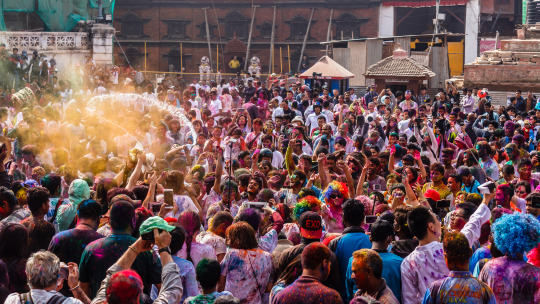
Fagun Purnima, also known as Holi, is named after the goddess Holika. Like many other festivals in Nepal, Holi is also linked to Hindu mythology. According to legend, a young man named Prahalad was a devotee of Lord Bishnu, who was considered a mortal enemy by his father, the demon king Mahisasur. Filled with rage, the Demon King commissioned his sister Holika, who possessed a flamethrower, to kill his son. After that, Holika sat in the fire holding Prahalad, but she died in the fire while the boy was alive. And to celebrate this glory, people play Holi, a festival of fun, color, and happiness. It said that it begins with the victory of good over evil. Holi has gained popularity among tourists. This festival is fun by splashing each other with colored water. Holi is celebrated on two different days. Nepal's northern regions perform it on the full moon day of February or March. Other Nepalese people do it on the day after the full moon day.
Chhath
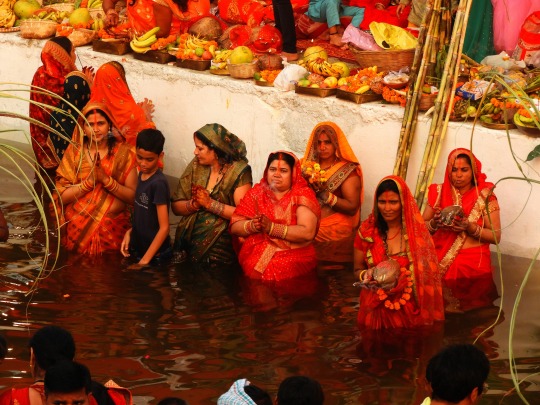
This festival is celebrated by the people of Mithila and the Terai people. The purpose of this celebration is to honor the Sun God for his mercy and light on people. The people fast during the day, praying for prosperity and wealth. After worshiping the sun, they had a feast. Other important rituals of this festival are holy immersion in the river, bathing in water, preparing special food for the Sun God, etc. After fasting, you can enjoy these foods. The best food to try during this festival is Anarsa and Thekuwa. Unfortunately, these dishes are not prepared during other seasons.
Buddha Jayanthi

Buddha Jayanti is celebrated to remember the birth of Lord Buddha. Gautam Buddha was born in 623 BC as the head of the Shakya dynasty in Lumbini, Kapilvastu region of Nepal. Being the birthplace of Budhha, Nepal celebrates Buddha Jayanti as one of its major festivals. It falls on the night of the full moon of May or June. Peace lovers and Buddhist communities love to make their pilgrimage to the birthplace of Buddha, Lumbini of Nepal on this beautiful day. The main destination to visit during this festival is Lumbini. Many tourists visited Lumbini to see the birthplace of Lord Buddha. Watch many beautiful and interesting shows, led by monks and nuns.
Maghe Sankranti

Maghe Sankranti is celebrated on the first day of the Magh month of the Nepalese calendar. It is a reflection of the holy month, usually in the middle of January. This festival is expected to bring the end of winter and hopes for warmer weather and better days of health and wealth. On this day, the family gathers together to eat a delicious meal together. People eat sesame seed candies, ghee, molasses, sweet potatoes, and ji according to tradition. Also, the same day is observed as Maghi - New Year in Tharu village of Terai. People celebrate this festival with family gatherings, eating varieties of food, going to Melas, wearing traditional clothes, etc.
Indrajatra

Indra Jatra is the festival of the Newar community in the Kathmandu Valley. It is an eight-day Jatra festival that falls in September. This festival also marks the beginning of the autumn moon festival season. It is done to remember when Indra came down to earth; According to Hindu mythology, Indra is the king of heaven. The chariot of the living goddess Kumari is taken through the streets of Kathmandu. Lots of people gather to enjoy the joyous procession led by masked dancers known as Lakhey.
Shree Krishna Janmashtami

Shree Krishna Janmashtami celebrates the birth of Lord Sri Krishna. According to Hindu mythology, Lord Krishna is considered the 8th avatar or "incarnation" of Lord Vishnu, who was born to stop the wickedness of his uncle "Kansh". Lord Krishna was an evil deity who was involved in many misdeeds as a child, including breaking pots and stealing butter from villagers. Therefore, during Janmashtami, there is a ceremony where a pot of butter is hung on top, and different groups break the pot for delicious food.
Mahashivaratri
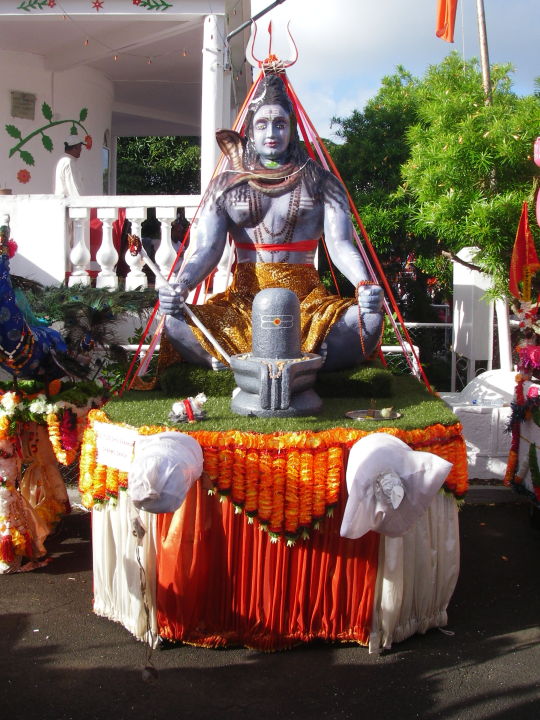
Mahashivaratri, or the night of Shiva, is one of the main festivals in Nepal. Lord Shiva is the supreme deity according to Hindu mythology. According to the belief of the day of Shivratri, the stars are in the best position which increases the spiritual power. On this day, thousands of Hindus visit the holy place of Hindus, Pashupatinath Temple, which is also considered the protector of the Kathmandu Valley in Nepal. During this festival, the Pashupatinath temple is decorated with flowers. Many Sadhus from India come to pray on Pashupati and perform the spiritual dance of Tandav of Lord Shiva on this day. As it is a nocturnal event, devotees celebrate the whole night, chanting and praying for light in the darkness. At home, people gather, light bonfires and prepare holy Shivratri food.
In Conclusion
Apart from these festivals, Nepal celebrates many other regional, national, and seasonal festivals. Since there are so many of them, every season of the year promises a rewarding experience. Make a plan for your trip with Alpha Adventure Treks to experience the exciting activities of Nepal. We are here to help you to find the best and perfect festival and unforgettable cultural tour in Nepal at your convenience.
0 notes